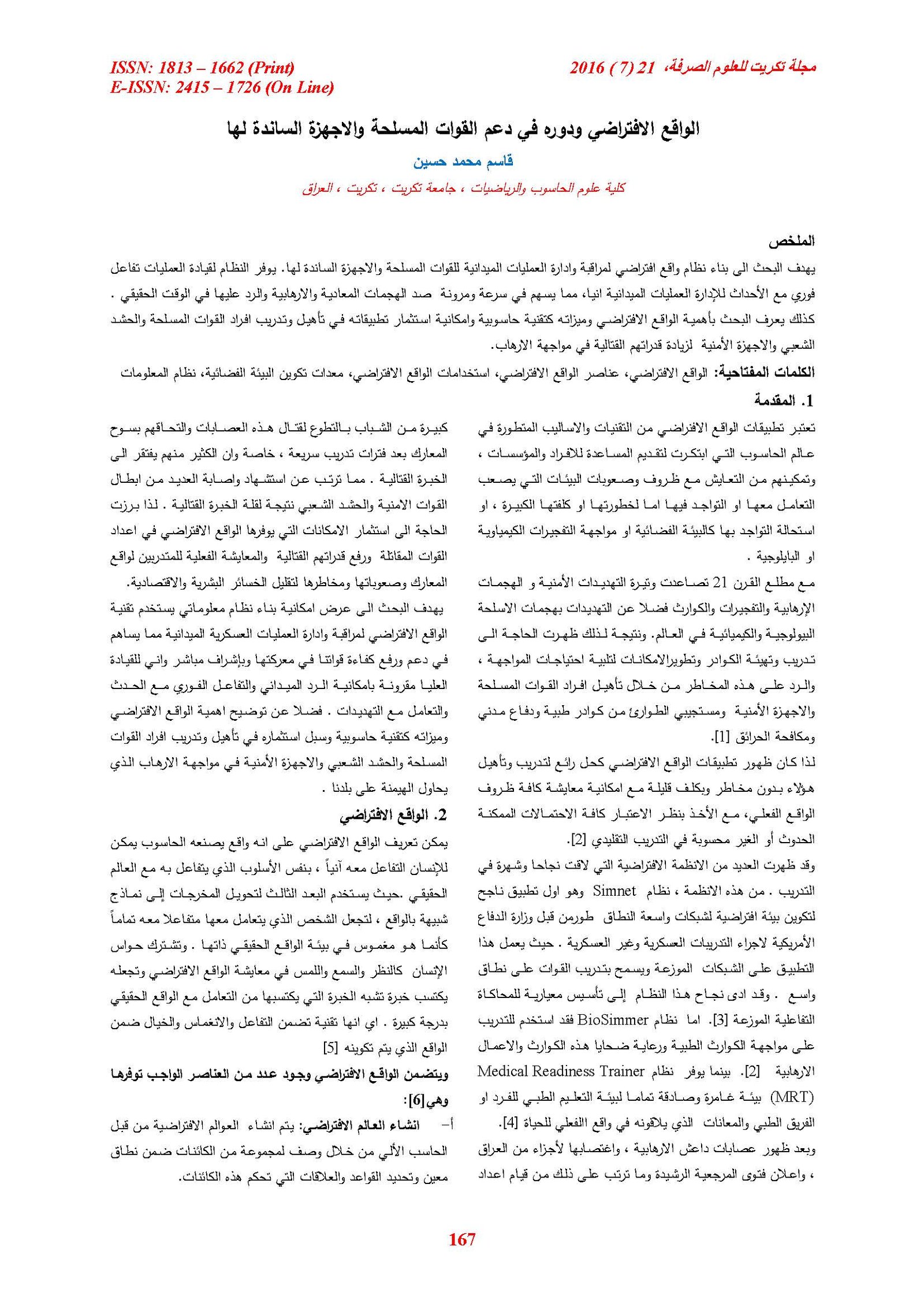Virtual Reality and Its Role in Supporting the Armed Forces and the Supportive Agencies
Main Article Content
Abstract
This paper aims to create a virtual reality system to control and management the military and the supportive agencies on-field operations. The system provides immediate interaction to the leaderships with the events to manage the on-field operations, which contributes in the increasing the speed and flexibility of repelling terrorist attacks and responding to them in real time.
As well as, the paper publicizes the importance of virtual reality and its features as a computer technique, and the possibility of investing its applications in the habilitation and training of the members of armed forces, popular crowd and security agencies to increase the combat capabilities of them in the face of terrorism.
Article Details

This work is licensed under a Creative Commons Attribution 4.0 International License.
Tikrit Journal of Pure Science is licensed under the Creative Commons Attribution 4.0 International License, which allows users to copy, create extracts, abstracts, and new works from the article, alter and revise the article, and make commercial use of the article (including reuse and/or resale of the article by commercial entities), provided the user gives appropriate credit (with a link to the formal publication through the relevant DOI), provides a link to the license, indicates if changes were made, and the licensor is not represented as endorsing the use made of the work. The authors hold the copyright for their published work on the Tikrit J. Pure Sci. website, while Tikrit J. Pure Sci. is responsible for appreciate citation of their work, which is released under CC-BY-4.0, enabling the unrestricted use, distribution, and reproduction of an article in any medium, provided that the original work is properly cited.
References
1. Sharmistha Mandal, Brief Introduction of Virtual Reality & its Challenges International Journal of Scientific & Engineering Research, Volume 4, Issue 4, 2013.
2. Yang-Wai Chow, Ronald Pose, Matthew Regan, The ARP virtual reality system in addressing security threats and disaster scenarios, IEEE Region 10 Conference Proceedings (pp. 1-6). Piscataway, New Jersey, USA: IEEE, 2005 3. J. Calvin, A. Dickens ; B. Gaines; P. Metzger; D. Miller; D. Owen, Virtual Reality Annual International Symposium, 1993., 1993 IEEE..
في جامعة النجاح الوطنية في نابم ، فمسطين . 2012 5. Zohra Ben Said. A virtual reality-based approach for interactive and visual mining of association rules. Software Engineering. Universit´e de Nantes, 2012 6. Renaud Ott, Mario Gutiérrez, Daniel Thalmann, Frédéric Vexo, "Advanced Virtual Reality
Technologies for Surveillance and Security Applications", VRCIA 06 Proceedings of the 2006 ACM international conference on Virtual reality continuum and its applications, 2006
7. Hanson, K., & Shelton, B. E. Design and Development of Virtual Reality: Analysis of Challenges Faced by Educators. Educational Technology & Society, 11 (1), 118-131, 2008.
8. A. Rizzo1, I. Cohen1, P.L. Weiss, J.G. Kim, S.C. Yeh1, B. Zali1 & J. Hwang. Design and Development of Virtual Reality Based Perceptual-Motor Rehabilitation Scenarios
9. Qingjin Peng, Virtual reality technology in product design and manufacturing –The design and implementation of a course for the graduate study. Department of Mechanical and Manufacturing Engineering, University of Manitoba, Winnipeg, MB, R3T, 5V6, Canada.
